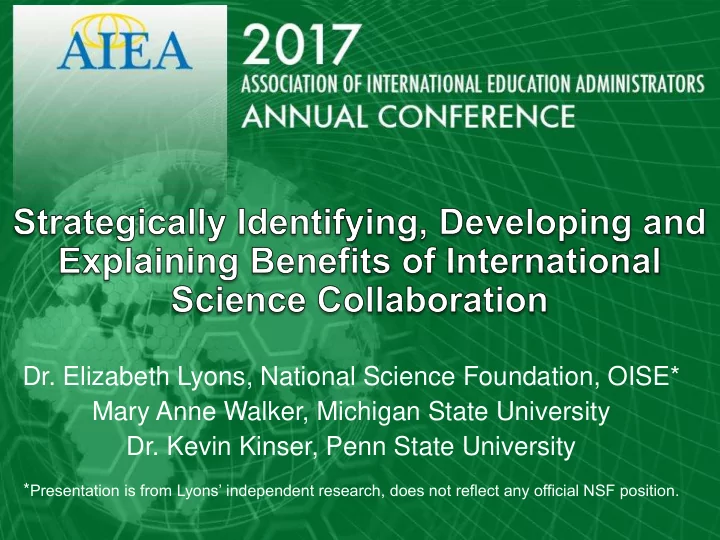

Dr. Elizabeth Lyons, National Science Foundation, OISE* Mary Anne Walker, Michigan State University Dr. Kevin Kinser, Penn State University * Presentation is from Lyons’ independent research, does not reflect any official NSF position.
Lyons 60,000 foot Perspective: U.S. Science in a Global Context U.S. R&D (blue) as percent of World R&D 2014 1981 International science collaboration national need tremendous opportunity for U.S. universities
Major Changes in World Science – Last 10-15 years --in the major players and focus areas -investments -innovation -outputs -science diplomacy --in patterns of participation and cooperation -co-authorship -internet access -higher education -mobility --in scope and potential -new technologies -global challenges -development -big science
Framework for Benefits of International Science Collaboration National Sub-National University Mission Scientific **** Education Economic **** Site-Specific Discovery Health *** Framework Service Diplomacy/Development * Setting Priorities Economic Growth National Security * Measuring Impacts Educational **** Articulating Benefits Social **** “How Collaborating in International Science Helps America.” E. E. Lyons, E.W. Colglazier, C.S. Wagner, K. Borner, D.M. Dooley, C.D. Mote, Jr., and M. C. Roco. Science & Diplomacy , June 2016.
Institutional Strengths/Potential Beneficiaries in International Science Engagement Scientific -faculty Economic -nearby industry -facilities -specific expertise -programs -natural resources -research networks -facilities Educational -programs, history Health-related -hospitals -students/alums -community needs -centers/Title VI -public health Societal -ethics/faith priorities Geography -proximity -demography -diaspora groups -local challenges -cross-border issues
Opportunity Mapping for International Science Engagement What benefits of international science collaboration are you already seeing? -leveraged funding -access to foreign expertise, data, facilities -globally engaged U.S. students -improved research networks -scientific excellence -increased trust, cultural understanding -access to foreign tech markets -better solutions for local issues -value added on global challenges -stronger international reputation
Opportunity Mapping for International Science Engagement What benefits of international science collaboration do you want to maximize? How can your institution/system/area add the most value in a global context? Where are strongest opportunities for your institution across the globe? Why is your institution a great partner for a foreign institution? How can you articulate your priorities so that your faculty, who often conduct curiosity-driven research, can participate in your intentional (strategic) engagement?
METRICS OF MOST Walker INTERNATIONAL UNIVERSITIES • Teaching (the learning environment) • Research (volume, income and reputation) • Citations (research influence) • International outlook (staff, students and research) • Industry income (knowledge transfer)
Structures to Support Global Science Development
ANALYTICS/TOOLS MOU DATABASE
Title- Please use Futura CORPORATE PARTNERSHIP DATABASE (Bold) • Text- Futura- (no smaller than 22 point font)
INTERNATIONAL FACULTY EXPERTS
Title- Please use Futura (Bold) • Text- Futura- (no smaller than 22 point font)
Global Impact Initiative
Academy for Global Engagement Faculty Development in International Research • Build a growing cohort of faculty to lead global research relationships • Capitalize on opportunities to leverage external resources and partnerships. • Be a force in developing global research project priorities and influence high-level strategies to address them.
Faculty-Driven Internationalization Kinser • Bottom-up not top-down • Matching discipline and department norms and values • Leveraging existing activities toward internationalization agenda • Creating interdisciplinary teams • Assessment program for project goals + internationalization
Extreme Weather Resiliency through Improved Weather and Climate Prediction & Public Response Strategies • International scientific partnership between U.S. and Taiwanese institutions [International University Research Venture] • Atmospheric Sciences, Emergency Management, Psychology (decision-making), Education, Center for International Education and Global Strategy • Research, student exchange, dual degrees, culture and language • Project manager as link between scientists and Int’l Education • Assessment: Network analysis
Co-authorship Analysis
Co-occurrence Analysis
Longitudinal Analysis
Recommend
More recommend